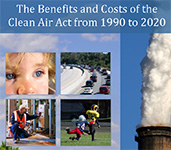Benefits and Costs of the Clean Air Act 1990-2020, the Second Prospective Study
In March 2011, EPA issued the Second Prospective Report which looked at the results of the Clean Air Act from 1990 to 2020. According to this study, the central benefits estimate exceeds costs by a factor of more than 30 to one. The report was updated in April 2011.
Healthier Living
Emissions control programs that reduce air pollution from smokestacks and tailpipes provide enormous air quality and health benefits today, and the benefits will grow over time as programs take their full effect.
In 2020, the Clean Air Act Amendments will prevent over 230,000 early deaths. Most of the economic benefits (about 85 percent) are attributable to reductions in premature mortality associated with reductions in ambient particulate matter.
| Health Effects | Year 2010 (in cases) |
Year 2020 (in cases) |
|---|---|---|
| Adult Mortality - particles | 160,000 | 230,000 |
| Infant Mortality - particles | 230 | 280 |
| Mortality - ozone | 4300 | 7100 |
| Chronic Bronchitis | 54,000 | 75,000 |
| Heart Disease - Acute Myocardial Infarction | 130,000 | 200,000 |
| Asthma Exacerbation | 1,700,000 | 2,400,000 |
| Emergency Room Visits | 86,000 | 120,000 |
| School Loss Days | 3,200,000 | 5,400,000 |
| Lost Work Days | 13,000,000 | 17,000,000 |
This chart shows the health benefits of the Clean Air Act programs that reduce levels of fine particles and ozone.
The remaining benefits are roughly equally divided among three categories of human health and environmental improvement: Preventing premature mortality associated with ozone exposure; preventing morbidity, including acute myocardial infarctions and chronic bronchitis; and improving the quality of ecological resources and other aspects of the environment, the largest component of which is improved visibility.
A Good Investment for America
The 1990 Clean Air Act Amendments programs are projected to result in a net improvement in U.S. economic growth and the economic welfare of American households.
Our central benefits estimate exceeds costs by a factor of more than 30 to one, and the high benefits estimate exceeds costs by 90 times. Even the low benefits estimate exceeds costs by about three to one.

This net improvement in economic welfare is projected to occur because cleaner air leads to better health and productivity for American workers as well as savings on medical expenses for air pollution-related health problems. The beneficial economic effects of these two improvements alone are projected to more than offset the expenditures for pollution control.
Learn more about the research to support the data in the study
Main page for Benefits and Costs of the Clean Air Act, and the Section 812 Studies

